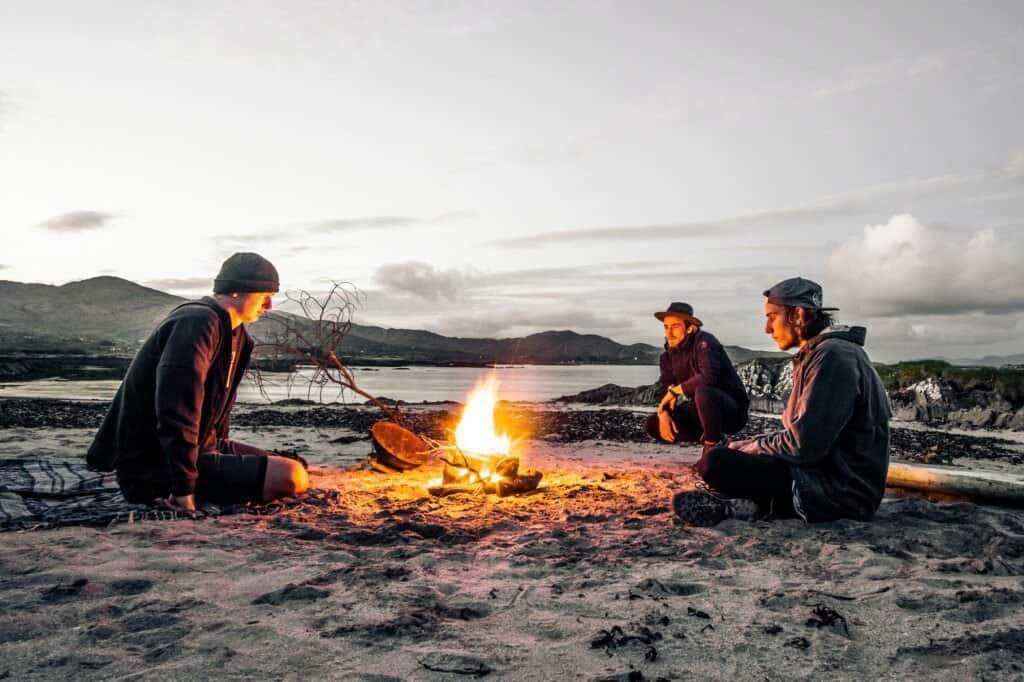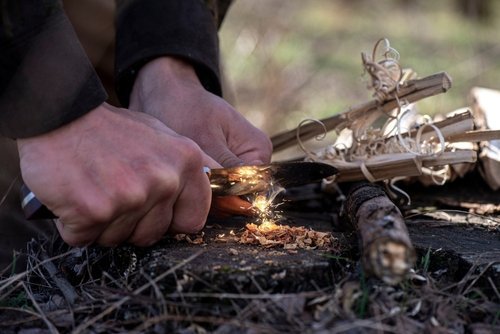
A common question among outdoor enthusiasts and survivalists is whether a ferro rod can still function when wet. This article explores the capabilities of ferro rods in wet conditions.
We delve into the properties of ferro rods that enable their functionality in wet environments and practical tips for using them in such conditions.
Composition and Wet Conditions

Metal Alloy Specifics
Ferro rods are made from a blend of ferrocerium, a synthetic alloy that includes iron (Fe), cerium (Ce), and other rare earth metals. This unique combination is designed to produce sparks at high temperatures when struck.
Water Resistance of Ferrocerium
The ferrocerium alloy’s inherent water resistance is key to a ferro rod’s wet-weather functionality. Unlike traditional flint, ferrocerium does not absorb water, allowing it to maintain its spark-generating ability even when exposed to moisture. This property makes ferro rods particularly valuable in damp or rainy environments.
Corrosion Resistance
Ferro rods are also resistant to corrosion, an important feature considering their exposure to various elements, including water. The alloy’s composition minimizes rust and corrosion, which could otherwise hinder its ability to generate sparks. Proper care and maintenance further enhance the rod’s corrosion resistance.
Impact of Water on Spark Generation
While water doesn’t prevent a ferro rod from generating sparks, it can impact the ease of ignition. In wet conditions, more vigorous strikes might be necessary to produce the same volume of sparks as in dry conditions. This factor is more about the difficulty in igniting wet tinder than the rod’s functionality.
Long-Term Durability in Wet Environments
Ferro rods maintain their integrity and functionality over time, even with repeated exposure to wet conditions. Their long-term durability is a testament to the robustness of their composition, making them a reliable tool for outdoor enthusiasts who frequently encounter wet environments.
Practical Usage in Wet Conditions

Preparation and Tinder Selection
When using a ferro rod in wet conditions, the preparation of your tinder is crucial. Opt for Tinder which is as dry as possible under the circumstances. Materials like dry grass, birch bark, or specially prepared tinder such as cotton balls soaked in petroleum jelly are effective. If the natural tinder is damp, try to fluff it up to expose drier parts. In wet environments, having an emergency tinder kit can make a difference in successfully starting a fire.
Striking Technique in Wet Conditions
The technique of striking a ferro rod in wet conditions may need to be adjusted for optimal spark generation. Striking the rod more vigorously and at a steeper angle can help compensate for any dampness on the rod’s surface. It’s also beneficial to shield the striking area from rain or falling snow during the process. Practice is key; familiarize yourself with the ferro rod’s feel and response in different environments.
Protecting the Ferro Rod and Striker
Keeping your Ferro rod and striker as dry as possible is important. While the ferro rod itself can function when wet, a dry striker will provide a better scraping surface for spark generation. Store them in a waterproof container or bag when not in use. If they do get wet, drying them off before use can enhance efficiency.
Building and Maintaining the Fire
Once you’ve successfully ignited your tinder, building and maintaining your fire in wet conditions requires careful attention. Start with small, dry kindling and gradually add larger pieces of wood, ensuring they’re as dry as possible. Creating a windbreak or rain shelter can help maintain the fire. Understanding how to effectively build a fire in challenging conditions is as important as the initial ignition.
Maintenance After Exposure to Water

Immediate Drying After Use
After using a ferro rod in wet conditions, it’s important to dry it as soon as possible. Gently wipe the rod with a dry, absorbent cloth to remove any moisture. Quick drying also ensures the rod is ready for immediate use next time.
Checking for Corrosion
Regularly inspect your ferro rod for signs of corrosion, particularly after it has been used or stored in wet conditions. Look for any discoloration or pitting on the rod’s surface. Early detection of corrosion can prevent it from spreading and affecting the rod’s spark generation capability.
Proper Storage
Store your Ferro rod in a dry and ventilated place. If the rod is frequently used in wet conditions, consider storing it in a container with moisture-absorbing materials, like silica gel packets, to help keep it dry. Avoid storing the rod in damp or humid environments.
Regular Cleaning
Clean your Ferro rod regularly, especially after use in wet conditions. Use a soft, dry cloth to remove any debris or residue from the rod. If necessary, mild soap and water can be used, but ensure the rod is thoroughly dried afterward.
Lubrication for Protection
Applying a light coat of oil or lubricant can help protect the ferro rod from moisture and corrosion, especially if it’s frequently used in wet environments. Use a lubricant that doesn’t impede the rod’s spark generation, such as a light mineral oil.
Routine Inspections for Wear
Conduct routine inspections of your Ferro rod for any signs of wear or damage. Frequent exposure to water can sometimes accelerate wear, especially on the striking surface. Replacing the rod before it becomes too worn ensures consistent performance.
Comparing Wet vs. Dry Performance

Spark Generation Efficiency
In dry conditions, a ferro rod typically generates sparks with less effort and more consistency compared to wet conditions. Moisture on the rod’s surface can slightly hinder the ease of scraping and the amount of sparks produced. However, even when wet, a ferro rod still remains functional. It may require more vigorous or repeated striking to achieve the same volume of sparks. This difference in spark generation efficiency is crucial to understand for users who rely on ferro rods in various environmental conditions.
Impact on Tinder Ignition
The condition of the ferro rod (wet or dry) can also impact the ignition of tinder. Dry conditions are generally more favorable for igniting tinder since the sparks are typically hotter and more plentiful. In wet conditions, while the ferro rod can still produce sparks, the challenge often lies in finding or preparing tinder that can catch these sparks effectively. Wet tinder may require additional preparation, such as fluffing or splitting, to expose dry fibers that can ignite more easily.
Durability and Wear in Different Conditions
Ferro rods are designed to be durable in various conditions. However, consistent use in wet conditions might slightly accelerate wear, especially on the striking surface. This is due to the additional force often required to generate sparks when the rod is wet. In dry conditions, the wear tends to be more gradual. Regular maintenance can mitigate these effects and prolong the lifespan of the rod in both scenarios.
Myths and Misconceptions

Myth: Ferro Rods are Ineffective When Wet
A prevalent myth is that ferro rods become ineffective or are unable to produce sparks when wet. This is not true. While the presence of water may require a more vigorous striking technique, the ferrocerium alloy’s properties allow it to produce sparks even in wet conditions. The misconception likely arises from a misunderstanding of the physics of spark generation, where the heat generated through friction is sufficient to ignite the metal shavings, regardless of the rod’s wetness.
Myth: Ferro Rods are Difficult to Use
Another common misconception is that ferro rods are difficult to use, especially compared to modern lighters or matches. The ease of use, combined with the rod’s durability and reliability across various conditions, makes it an accessible tool for anyone willing to learn the basic technique.
Myth: Ferro Rods Wear Out Quickly
A misconception exists that ferro rods wear out quickly and need frequent replacement. This is not the case. Ferro rods are designed for durability, with a single rod capable of thousands of strikes. The rate of wear depends on usage frequency and striking technique, but generally, a ferro rod lasts significantly longer than traditional fire-starting tools like matches or lighters. Understanding the rod’s composition and proper striking technique can ensure its longevity.

FAQ
Q1:How do I sharpen a worn ferro rod?
A:Generally, ferro rods do not require sharpening. If the surface becomes smooth, lightly scraping it with a rough edge or sandpaper can expose fresh material for effective spark generation.
Q2:Can ferro rods be used at high altitudes?
A:Yes, ferro rods are effective at high altitudes. Unlike some chemical-based fire starters, their performance is not affected by lower oxygen levels or air pressure.
Q3:Are there any special storage requirements for ferro rods?
A:Ferro rods should be stored in a dry place to prevent corrosion. No special storage conditions are required, but keeping them away from humid environments can prolong their lifespan.
Q4:How can I tell if my ferro rod is of good quality?
A:A good quality ferro rod will produce a shower of hot sparks with minimal effort. It should feel dense, and the sparks should be bright and consistent. Reading reviews and purchasing from reputable brands can also ensure quality.
Q5:Can I take a ferro rod on an airplane?
A:Generally, ferro rods are allowed in checked luggage on airplanes. However, it’s always best to check with the specific airline’s regulations beforehand to ensure compliance with their policies.
Conclusion
In conclusion, Ferro rods demonstrate remarkable resilience in wet conditions. Despite common misconceptions, their unique alloy composition ensures they remain a reliable fire-starting tool even when exposed to moisture. By understanding the proper techniques for use and maintenance in wet environments, outdoor enthusiasts and survivalists can confidently rely on ferro rods as an essential component of their gear, capable of performing under a variety of challenging circumstances.

